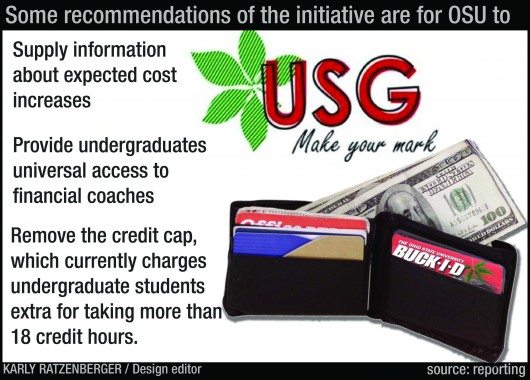Undergraduate Student Government’s Affordability Initiative is losing traction, following a lack of interest from the Ohio State administration.
“As of this moment, we have not had any points which the university has said they want to work with us on, which I am very disappointed to see,” said USG President Taylor Stepp, a fourth-year in public affairs.
“Frankly … there’s no reason we can’t work together on these issues,” Stepp said.
Stepp said OSU officials, including faculty leaders and members of the Senior Management Council, have been approached over the last few months to talk about the initiative, but he declined to name which university officials were approached by USG.
OSU spokesman Gary Lewis did not provide comment from OSU officials who were involved in the talks, but sent a university statement in an email saying OSU is “fully committed to broadening access and increasing affordability to a diverse student population.”
“We appreciate the leadership of USG President Taylor Stepp and the efforts of the commission in addressing these critically important and national challenges in higher education,” Lewis said.
Vice President for Student Life Javaune Adams-Gaston told The Lantern Nov. 19 she had spoken with members of USG about the initiative.
“We’ve had lots of conversation and I really appreciate Taylor and USG for taking this as a very serious issue in the same way the university takes this as a serious issue,” she said. “I like what he has outlined.”
A Nov. 21 press release from USG defined the Affordability Initiative as a “holistic, proactive approach to combat the problem of student debt and improve college affordability at Ohio State.” The initiative is based on findings of the Commission to Rethink Access, a USG committee that researched ways to make OSU more affordable.
Some recommendations of the initiative were for OSU to supply information about expected cost increases, provide undergraduates universal access to financial coaches and remove the credit hour cap, which currently charges undergraduate students extra – about $199 for Ohio residents and about $526 per additional half credit hour – for taking more than 18 credit hours, according to a USG release.
While parts of the initiative have changed since its initial conception, Stepp said the administration was consulted throughout its formation and knew about the specifics “well before” the initiative was announced.
“Every one of our points is solidified, and we have reports and data and everything that we need to make our case,” Stepp said. “The broader argument has been there for quite some time.”
USG also sought student input when forming the initiative.
“I haven’t had any student tell me anything other than the fact that they are very much looking forward to us accomplishing some of these goals that are listed in the initiative,” Stepp said.
USG plans to speak with federal officials about its Affordability Initiative in April at a yearly “Big Ten on the Hill” conference in Washington, D.C., Stepp said. USG representatives will meet with member of Congress, members of the Consumer Financial Protection Bureau and White House officials.
John Grusenmeyer, a first-year in sustainable plant systems, said he supports the ideas behind the initiative.
“It would be nice for (the administration) to work with (USG),” Grusenmeyer said. “School is really expensive.”
Patrick Conlon, a third-year in English, agreed.
“It’s frustrating when the administration tells us that (students) have power, and when USG tries to impact real change, OSU drags their feet,” Conlon said. “It’s like they let us play government until it matters, then they have the Board of Trustees … make the decisions.”
With money on many students’ minds, Stepp said he expects action from OSU on at least some of the points of the initiative.
“We put forward a plan,” Stepp said. “There is no administration plan to tackle affordability. And we said, ‘If you aren’t going to tackle it, we will.’”
Daniel Bendtsen contributed to this story.



